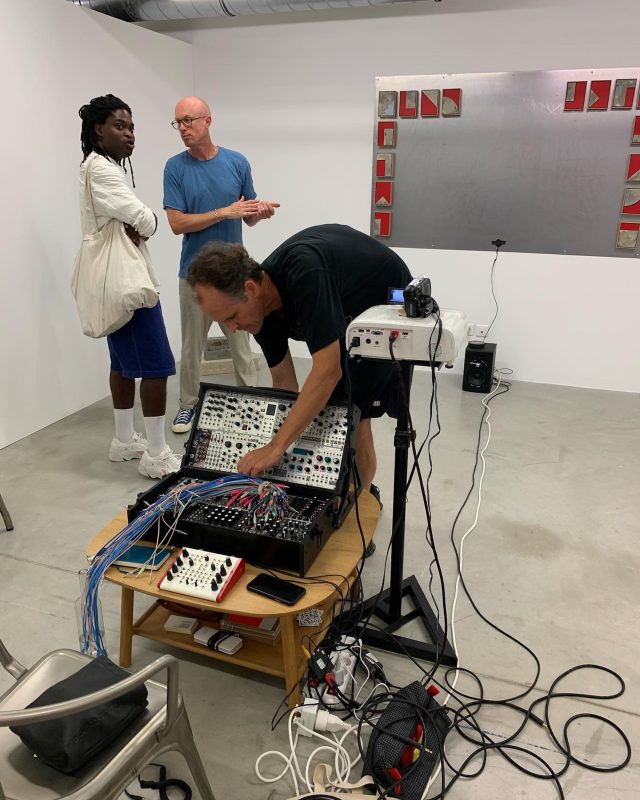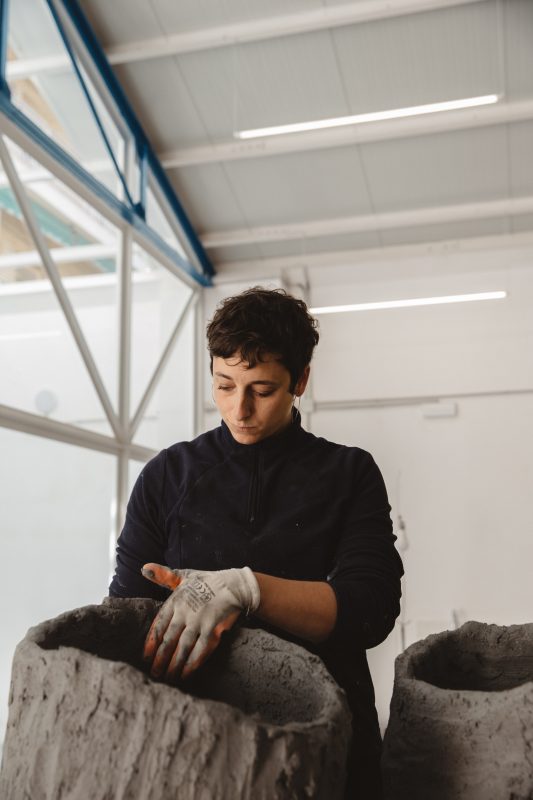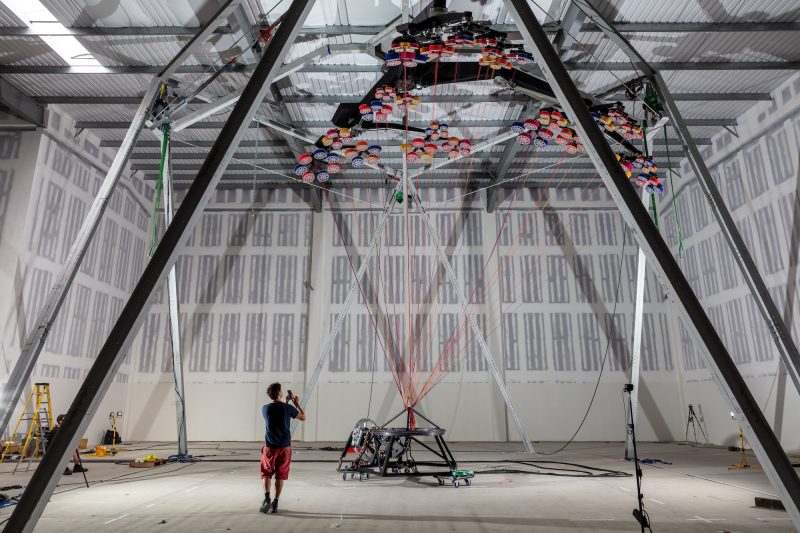PUBLIC Gallery presents Unblock Me You Coward, a solo exhibition of London based artist Lung. The show features a new series of paintings and a 30-meter-long sky dancer in which Lung engages with what he has come to call the ‘semi- ecstatic’. This unapologetic, yet visibly homemade technique literally and metaphorically fills up the subconscious and then let it spill out.
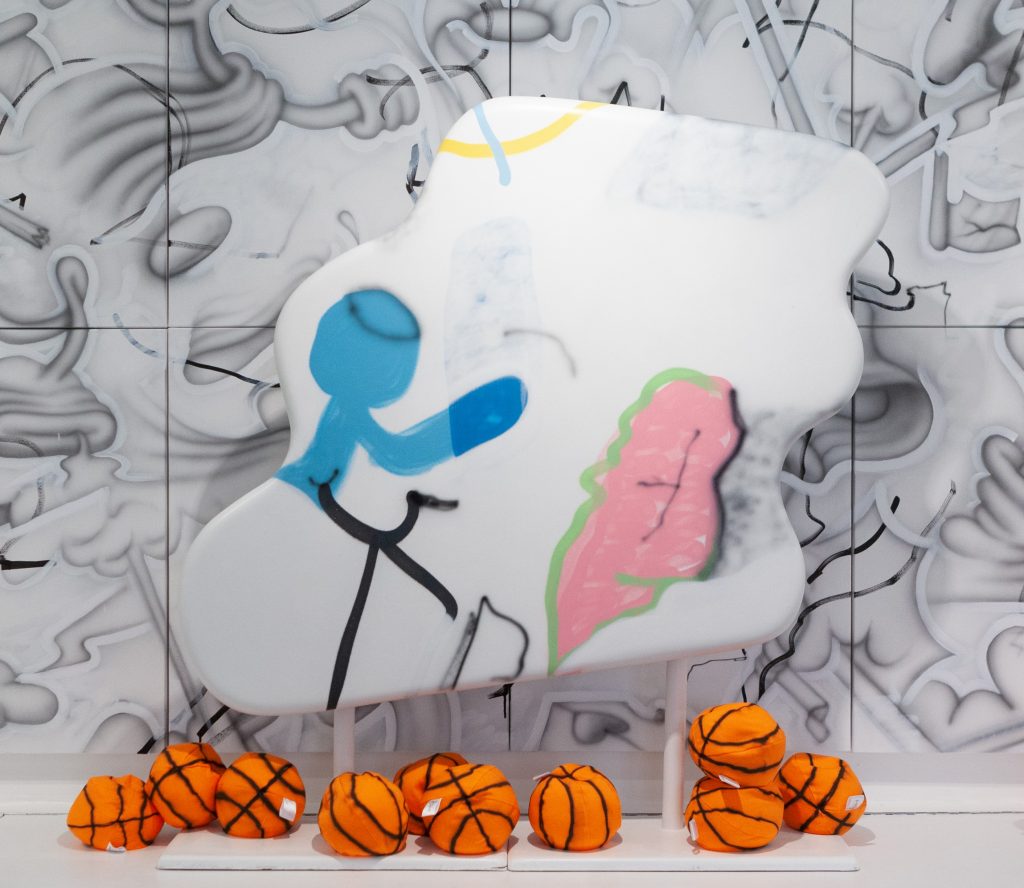
This ecstatic purge process is a long-time companion of the artist. Its aim is to erase the rational, mediated passage between mind and hand. The much appreciated link researched by all artists and humans in Renaissance is here despised. Lung’s ecstasy (as any, really) produces uncalculated, quickly made, marks that exist in a world where everything is touched by the same discordant horror hand. The only way to escape this demonic agent seems to be to devoid anything of its timely, rational anchorage. For Lung thinking whilst making the marks is a failure, if he can see a logic in them afterwards the effect is nullified. The works have to constantly surprise to be effective and have no knowing mark making, therefore must not be contrived or planned.
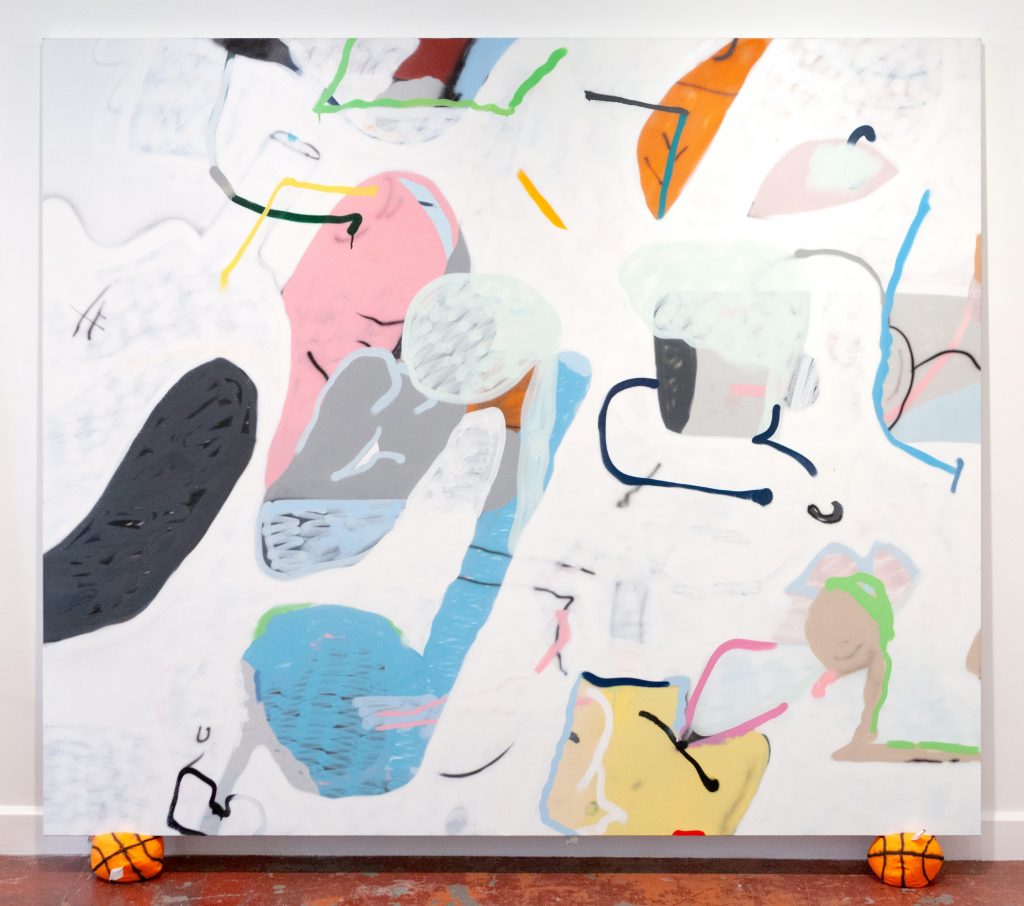
“I guess it’s like some nut job getting high and swishing paint around, but the process of getting to the semi ecstatic can be hard work, it involves not just filtering inspiration but programming myself with the right mode. Filling up with the right petrol but also sometimes it’s good to ruin the tank, like it can be a looped pop chorus or a scene from a film combined like a mantra playing in the subconscious. Through that comes something new, not always good, but if it feels like it came from a non- precious subconscious then I don’t paint over it.”
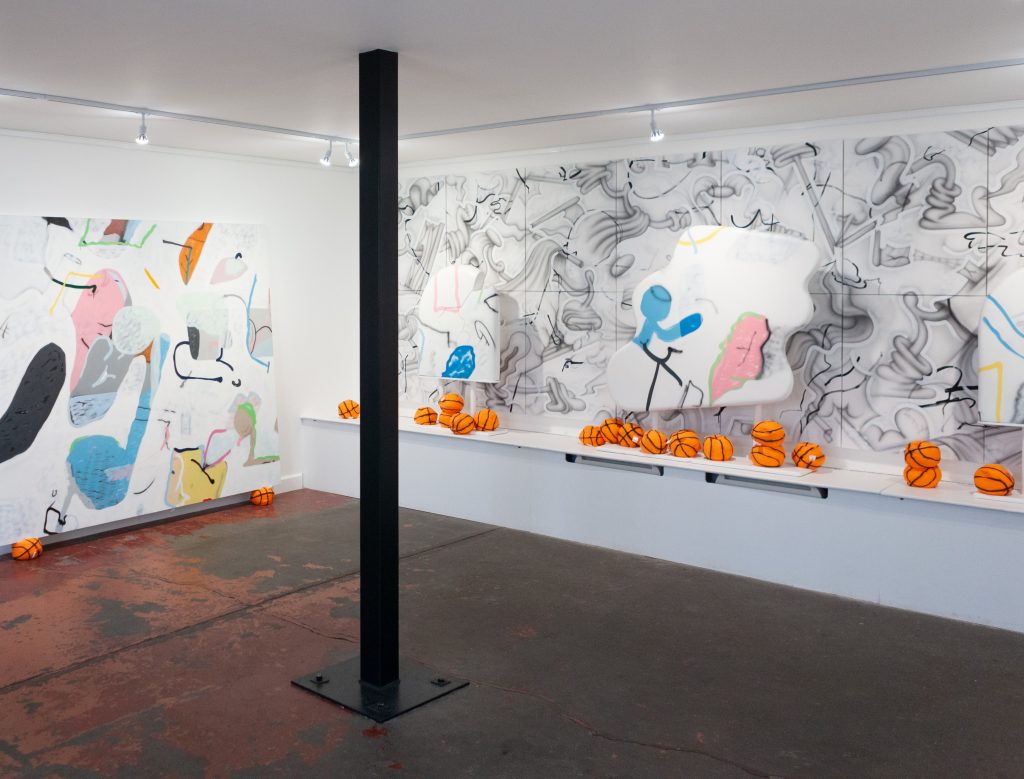
The abstract comic sensibility seen in Lung’s work is mixed up in an ethereal world which fuses token signals with demented renderings, all of which are gathered from the world around us. They are pushed through the semi-ecstatic funnel, and finally plop onto the work in varying degrees of un-glory. The results are highly innovative and always surprising (never boring!) works that combine an incredible arrays of references. Expect to find intellectual, mythological concepts married with to grunge vibes.

“If I have to sum it up at the time of writing, I’m channelling that feeling when you hear the same bit of library music advertising both blood pressure pills and dog biscuits or when you see a continuity error in a film, the actor gets out of the pool then they’re hair is dry in the next scene a second later. This is as anti-edit, this is cutting to a 5 min shot of him drying off even though you’ll lose the audience”

Read my interview with the artist here, where he explains in detail his working process and his techniques (I must say his words are as appealing as his art pieces)
The titles of the works are clearly evocative, with a mixture of mythology and electro music (Gorgon Siren), amateurish violence and political/social critique [DIRT MECHANIC (MALL NINJA EDIT)], and other pungent word plays. Where do you take the inspiration from?
All the titles quickly identify the phase I was in at the time of making: not to give new meaning but to attach words so I can quickly access it. They’re usually left to the last minute, before showing or publishing. They’re not over complicated or clever, they just need to shift me back into the state I was in.
The titles hint at scenarios but they’re put through a vocabulary shift that suits it better. If I were to call them more explicit obvious descriptors, I might as well be archiving lost property, or something. concrete. For example, Gorgon Siren came about from being woken up on the day it was done by a succession of loud alarms. The Squish Cat part of it was a dead jazz musician I was listening to on a degrading loop. Both these things repeated and distorted together to make a kind of demented birth and death techno.
As I’ve just indicated, to explain them kind of reduces their meaning and slows them down a little bit. To make obvious can weaken the hit. For years, growing up, I resented titles on music and art, preferring to reference by feeling. Now, I see people connecting with language; it helps the process. Bit like word lube. The ‘feat.’ aspects of the titles and ‘remix’ and ‘reprise’ are in there because I see them as releases into the world and I want them to exist away from over prescribed art title talk.
Instead, I want them to clutter and fester like old dance 12’s in a loft, I connect with the straight forward language of titling on dance music… who did what, and what it is. Thhinking about it now, they too were not meant for everyone otherwise they wouldn’t be covered in dust in a loft.
Can you expand on the concept of the semi-ecstatic?
It’s the process, one which everyone does from time to time, either before an interview, or a performance maybe. Put simply, it’s me gathering up emotions, sounds and visions in my head, and harnessing them. Like the robot thingy does in short circuit. Not going mentally overloaded, but for me more of a partially filtered process. That’s where the semi bit comes in. It’s not full on ‘go and swish paint around,’ ‘I am art’ kind of thing, that gets boring very quickly. It’s more to get myself ready for my scene, so to speak. Working to my own brief. I go with what is happening and shape it into a subconscious mood or level. That usually continues for longer than what it takes to actually make the work.
It gives me a diet and a circus to play in: it’s news, life and detritus regurgitated through me. It’s like people’s paintings of vases and flowers: it’s not enough. I like flowers, but, unless they work in a florist, I want the next one to be something else. I prefer to feel what’s happening to that person, rather than experiencing what they want you to see is happening to them. I would rather have pure phase, even if it looks weird.
For example, let me go back to when I said about the alarms and jazz death. I tried to connect them to enhance it. I was forced into taking a sample of the dead horn pumper and repeating it to make me as angry as that alarm did. It was kind of like a rude free form parp of joy, over and over again, bringing about a psychosis. It ended up being a kind of anger turning into hysteria. Just looking at it now, you can see sick notes in it. I would never have even noticed if not for explaining here.
I guess that is precisely what the semi-ecstatic is for me: a psychosis that is seldom explained in detail and after its made, it’s referenced with a tag around its toe and stacked up with the others. This metaphor probably sounds a bit like a morgue, but I’m thinking about not in terms of a birthing centre, with lots of strobe lights and music playing, and trays of food…
The semi-ecstatic seems to be gaining a distance from the rational, premeditated creative process. More than about having the right composition, or the best colours, it seems closer to an abstract expressionism, in its most literal interpretation. It is connected to the expression of the abstract, the emotion. What is painting to you, then?
In my world I try and place painting in a bigger context. I would never do a painting solely about colour and shape, it might look like that, I have no idea what it might look like actually, but I have to have something to connect it to my induced reality. So, everything is suppressed inside, until it’s time to make. I then give it an hour tops until its bashed into shape. Like someone looking through my browser history and writing a quick poem about it: explicitly and brutally honest, but hopefully with a bit that rhymes here and there.
Also, in terms of how it’s actually made, it’s a very physical, quick, process. It’s one which can be erased only by going over it. One of the greatest examples of slow communication and half intent I see around the city is the erasing of graffiti with another spray can. The owner of the van has used one can of cream colour to try and white out something. He run out halfway through, with the necessity to try and cover and erase as much as possible of what they saw when they woke up that morning. To me, leaving a trace of what infuriated them, says ‘this shouldn’t be here, I want it gone.’ I get the idea, but I ran out of paint. Its quick and mostly dirty, but we get it.
Do you aim the purge process more at yourself, or at beholders?
It’s definitely more for me. Surprisingly, the more people engage with it, the more they get it. It’s like learning a language. If you go to a noise show or a circus and don’t look into the DNA of what’s happening, it’s is just noise, or a dog riding an elephant. But if it shows its structure it can be enticing and enjoyable.
Recently I’ve started using spray cans to work quickly, the drying time is perfect for repeated quick covering. Using that material puts me in a box immediately, but there’s nothing better. Plus, the fumes help. I’m aware that, deep down, some people don’t like that aesthetic, but I can’t change. If I’m really trying to think about it, I could change it and get it out there more, expand on everything and push it. This would ruin the ingredients and, therefore, the baking would suffer. I need it the way it is.
It’s not important that people see anything other than the work. It is what it is. Some people like it, some don’t. But on my travels, I do come across people who totally get it. And now I think I’ve turned the speakers in their direction a bit. I didn’t change the works, but ordered them in a way that I know will make people laugh, or make a connection.
When people hang them in their home, I’m under no illusion that maybe they just like it. Or, maybe, the blue goes with the couch, it does something for them. For me the painting might be a mixture of emotions and topics from the real time. For them, it’s just a bit of blue and white or whatever. Or it’s a thing that looks like a bagpipe on a bin. That’s great, if not greater than all the crap I’m talking about. And much easier to write about. I wish I’d just said that now.
How and why did you come to such an ironic, yet clearly critical, aesthetic/content?
I think years and years of finding out what makes me feel like it’s still active on the surface, whilst being careful of not falling for the trappings of finding a look and repeating it. I’ve loved and hated art in equal measure. I think, to be honest, it has to be like that. I flip between thinking art is everything, or nothing. Deadly serious, and stupidly wistful. I love the creation of it, but I’m not so keen on where it goes to school. There are bullies there, the music room is woefully under-stocked, and the uniform is weird. Defining a process, it’s equally healthy to reject or to embrace. To get truly free takes some time, I guess. It has resulted in me having to do it. I’m speeding though this as quickly as possible, so I can go and make more.
How do you relate to the cultural/social realities involved in your works?
I relate to them in the sense that I let them overwhelm me. I’m writing a script as I go along and as I go over the lines it starts to become me. It’s all confined to the studio, but I make the process as heavy as I can, in any way, to effect change. I’ve set myself stupid parameters, so I can’t make my feelings explicit, no words or obvious signs or signifiers. So, I have to connect with what’s happening around to give me ammo. Then, it just pukes itself out in a very unceremonious way. If there was a connection to an obvious reality after that initial plop onto the gravel, its meaning will have expired. Like a pun or a slogan. If I leave them for a year, then look at them again, I want them to be still moving. Much like how you want to find your friends.
Unblock Me You Coward, PUBLIC Gallery 8th November – 24th November publicgallery.co.uk
